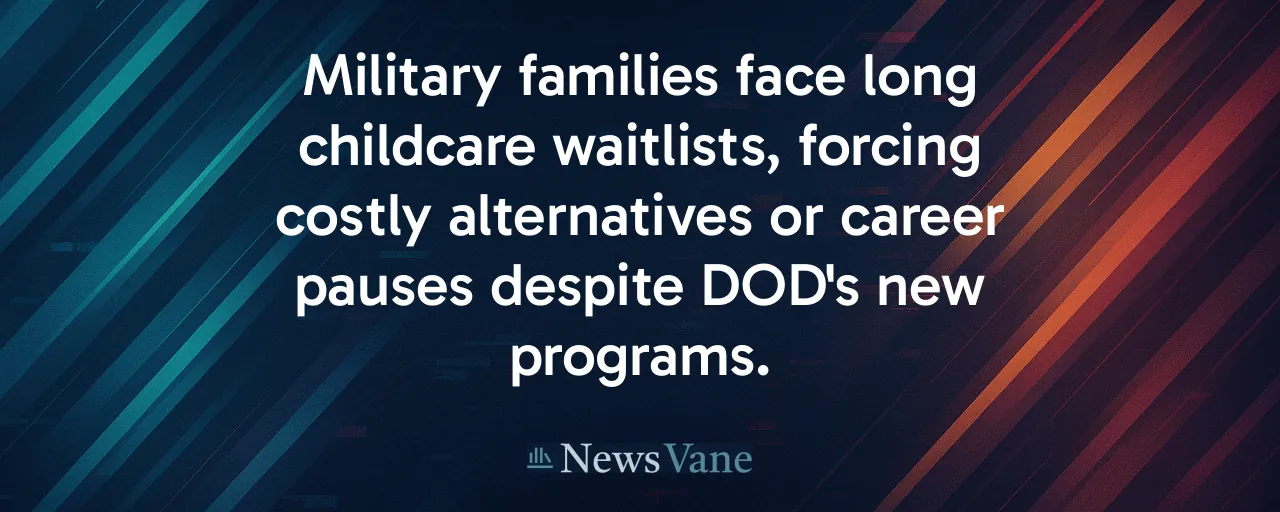The Child Care Struggle Hits Hard
Military families know the drill: long waitlists for on-base child care, sometimes stretching over a year, throw life into chaos. Parents scramble for costly off-base options or pause careers entirely, while service members juggle mission demands with worry about home. The Department of Defense is stepping up with new programs to ease the burden, but the challenge runs deeper, echoing a nationwide shortage that leaves millions of families stuck.
The problem extends beyond military families. Half of U.S. parents struggle to find affordable, quality care, with costs swallowing 10 to 32 percent of their income, according to a 2022 survey. For military households, frequent relocations and remote postings make it tougher, wiping out waitlist progress and limiting access to base facilities. The ripple effects hit hard: parents lose job opportunities, and military readiness takes a hit when families lack support.
Why Slots Are So Hard to Find
The crisis boils down to a stark mismatch: too few providers, too many kids. Since 2019, the U.S. has lost 16,000 child care centers, and rural areas often have no slots for young children. The DOD runs the country's largest employer-sponsored child care program, but it's stretched thin. Chad Sheldon, a DOD official focused on youth programs, points out that building new on-base centers can't keep pace with demand, and many families live too far from bases to use them.
Money is a sticking point. Military families fork out about 15 percent of their income for care, far above the 7 percent affordability guideline. Civilian parents pay a similar price, with center-based care averaging $11,582 yearly. Low wages for child care workers drive turnover, hurting quality. The pandemic made things worse, shuttering centers and pushing staff toward higher-paying jobs, leaving families and employers scrambling for solutions.
DOD's New Playbook
The DOD is fighting back with fresh ideas. Its Military Child Care in Your Neighborhood program now includes MCCYN-PLUS, which taps state quality ratings to approve more off-base providers, helping families in areas with limited options. The Child Care Expansion Initiative teams up with nonprofits like the Armed Services YMCA to open new centers. A Norfolk, Virginia, facility just started serving 200 kids, with more sites planned for Virginia Beach and the National Capital Region by 2026.
Other efforts get creative. Buydown programs reserve spots in commercial centers for military families in places like Jacksonville, Florida, and Colorado Springs, Colorado. For parents with odd hours or special-needs kids, the Child Care in Your Home pilot covers in-home care costs. A relocation program reimburses travel expenses for temporary providers after moves. These steps aim to cut wait times and keep costs in check, offering relief where it's needed most.
Weighing Different Fixes
Solutions spark debate. Some policymakers push for universal subsidies, citing states like New Mexico, where state-funded care reaches most young kids, as a blueprint for stabilizing families and boosting jobs. Others favor tax credits or looser regulations, arguing parents should have freedom to choose home-based or faith-based care. They worry big public programs could inflate costs or squeeze out smaller providers, leaving some families with fewer options.
Still, advocates for broader systemic change point out these programs only reach a fraction of families in need. With 44 percent of military spouses saying child care blocks their careers, and civilian parents losing billions in earnings due to shortages, the stakes are clear. Everyone agrees reliable care matters for families and the economy, but finding common ground on how to deliver it remains a work in progress.
Looking to the Future
The DOD's new programs chip away at the child care crisis, but the gap remains wide. Long waitlists and high costs still weigh on military families, and the broader shortage hits civilians just as hard. From employer-backed centers to state-level funding, new ideas are critical. The cost of doing nothing is massive: $122 billion a year in lost productivity, not to mention the stress on parents trying to make ends meet.
For now, the DOD's focus on partnerships and flexibility brings hope. By collaborating with communities and tailoring support to varied needs, the department is proving progress is possible, even in a strained system. Military families are watching, eager for a time when quality care is a given, no matter where they're stationed.
No quick fix will solve this crisis, but every new center and subsidized slot helps. For military parents, it's about peace of mind: knowing their kids are safe while they serve. As efforts grow, the aim holds steady: build a system where families can thrive, whether on base or beyond.
